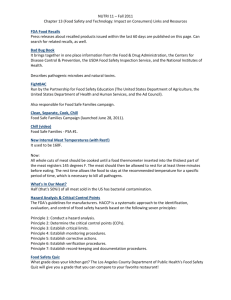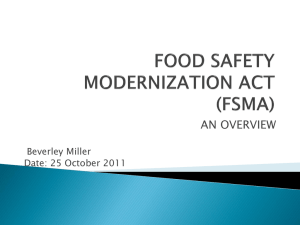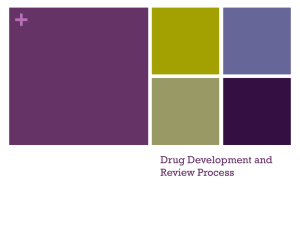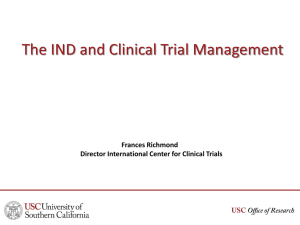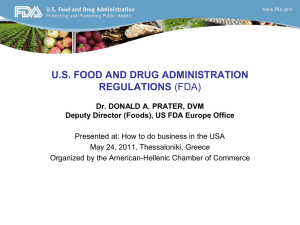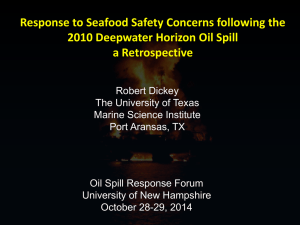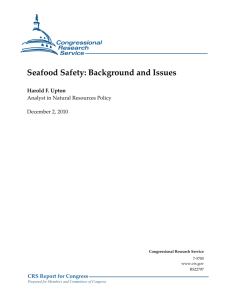Click here to the powerpoint presentation
advertisement
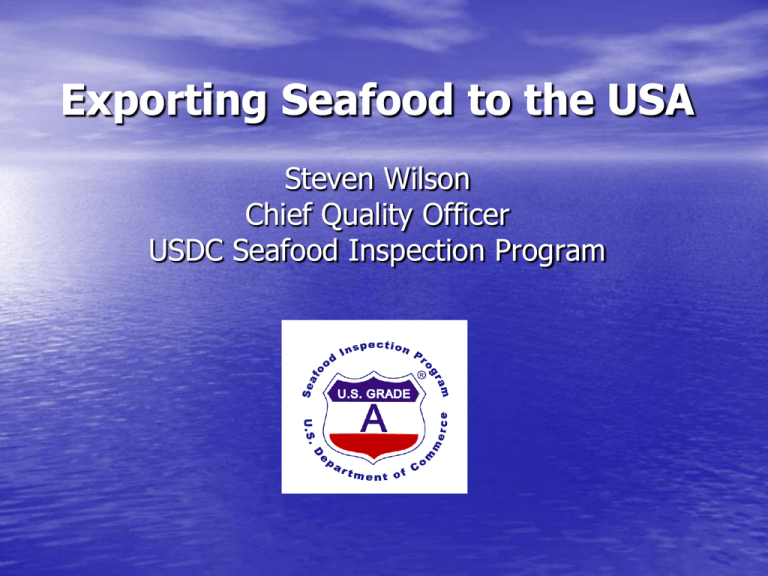
Exporting Seafood to the USA Steven Wilson Chief Quality Officer USDC Seafood Inspection Program U.S. Food Safety Agencies USDA EPA HHS USDC FDA NOAA Mandatory Regulatory Compliance Voluntary, Regulatory Compliance plus product quality inspection services Overview • • • • Federal Voluntary Fee-for-Service Domestic and Overseas Services • In-plant Inspection & Certification • • – Continuous – System Evaluation Lot Inspection & Certification Consultative Services – HACCP Plan Development and Validation – Third Party Verifications – Training – Analytical testing Participants & Beneficiaries • Harvesters • Processors • Distributors • Retailers • Food Service Operators • Importers and Exporters • Foreign Processors • Foreign Governments Consumers Seafood Imports • Over 85% of Seafood Products Consumed in U.S. are Imported • Numerous Species & Product Forms • Originate from Countries with Wide-Ranging Infrastructure, Capabilities, & Controls Stakeholders • Public • Industry • Legislative Bodies • Government Agencies • Consumer Advocate Groups Drivers • Buyer/Supplier Relationship • Liability Concerns • Media Coverage • Technically Savvy Public • Alternative Choices are Abundant Recent Legislation • Public Health Security and Bioterrorism Response Act of 2002 (Bioterrorism Act) – Prior Notice – Registration of Firms Exporting to USA • Farm Security and Rural Investment Act of 2002 (2002 Farm Bill) – Country of Origin Labeling (COOL) • 2008 Farm Bill Emerging Program Requirements • ISO 9001 • Customer Quality Requirements • Food Defense • ISO 22000/PAS 220 Specific Concerns of Aquaculture • Pollutants • Drug Residues • Economic Integrity • Cost of Production • Vast Number of Raising Areas Supplier/Buyer Relationship • Supply Chain Management • Use of Approved Suppliers • Buyers Specification and Verification • Importers Gaining Prominence System Evaluation • Process Analysis and Control • Traceability • Documentation of Procedures • Recording Results End Item Evaluation • High Comfort Level • Economic Fraud Concerns • Liability Concerns • Statistical Inference of Results • Sensitivity of Analyses Agencies on Import to USA • USFDA • USDA-FSIS • USDA-AMS • USDA-APHIS • USDC-NMFS Animal and Plant Health • Animal Plant Health Inspection Service • National Marine Fisheries Service Food Safety Inspection Service • Meat – Beef – Pork – Rabbit – Horse – Etc. • Poultry • Eggs Reinspection at Import • After product clears U.S. Customs product is reinspected • Assignment is computerized and dependent upon • • • compliance history Type of inspection is determined: net weight checks, condition of container, product defects, incubation of canned goods and laboratory analysis Additional random sampling for drug and pesticide residues Shipment is usually released before results are obtained Agricultural Marketing Service • Fruits • Vegetables • Dairy • Tobacco • Cotton Market Orders • Must meet the same or comparable grade, size, quality and maturity requirements • Avacados, dates, hazelnuts, grapefruit, table grapes, kiwifruit, olives, onions, oranges, Irish potatoes, plums, prunes raisins, tomatoes, walnuts • Products checked at border posts by U.S. Customs U.S. Food and Drug Administration • Responsible for All Foods except meat and poultry • Also responsible for various other products (toys, blood, medical devices, pharmaceuticals, etc.) Snapshot of Seafood Laws and Regulations (FD&C Act) • 402 a(1) Food Contains Poisonous or Deleterious • • • Substance 402 a(2) Food Contains Added Poisonous or Deleterious Substance 402 a(3) Food Contains Filthy, Putrid, or Decomposed Substance 402 a(4) Food Prepared, Packed or Held Under Insanitary Conditions Whereby it May be Contaminated with Filth or Whereby it May have been Rendered Injurious to Health Snapshot of Seafood Laws and Regulations • GMP Regulation (21 CFR 110) • Seafood HACCP Regulation (21 CFR 123) • Low Acid Canned Food Regulation (21 CFR 113) • Guidance (e.g., Fish and Fishery Products Hazard Guide) Requirements for Imported Seafood • Must appear to meet the requirements of the FD&C Act • Produced in compliance with the Seafood HACCP regulation or be from a country with an MOU or similar agreement • Importer must show affirmative steps • Importer of record must have product specifications ensuring compliance Types of Detention • Detention of an Individual Entry (based on Sample Collection or Physical Examination) • Detention Without Physical Examination Detention Criteria • Recommendation of FDA After a Regulatory Visit • Recommendation of a Foreign Competent Authority • Shipment Appears Violative Violative Sample • Product may have adverse health consequences • Product contains actionable levels of pesticides, aflatoxin, or chemical contaminants Violative Sample • Not in compliance with low acid canned food regulations • Contains unapproved or misused ingredients or additives • Not in compliance with nutritional labeling education act (Retail packages) Procedures for Individual Detentions • Appears violative (damage packages, thawing, etc.) • FDA samples and analyzes lot • Lot released if no violation • Non-violation does not affect future shipment • Violative product not allowed entry Detention without Physical Examination • A Shipment has the appearance of adulteration under the FD&C Act • Based on an Import Alert issued to address a perceived problem • Firms, Countries, and Regions may be subject to DWPE How to Get Off DWPE • Firms must have 5 compliant shipments in a six • • • • month period At least one shipment audited by FDA to ensure analytical validity Shipment must represent usual products and different production runs Countries and Regions must have 12 compliant shipments Apply to the Division of Import Operation Policy Removal From DWPE • FDA must be assured that firms are compliant • • • • over a reasonable period to remove from DWPE FDA needs adequate product for sampling FDA may request other documentation Shipment must be compliant to all other provisions of US laws and regulations FDA may require an establishment inspection Bioterrorism Act Requirements • All Food Firms must be registered – Online at http://www.cfsan.fda.gov/~furls/ovffreg.html – By mail or fax with Form 3537 available at http://www.cfsan.fda.gov/~furls/papercd.html#forms – Address: U.S. Food and Drug Administration, HFS681, 5600 Fishers Lane, Rockville, MD 20857 – Fax: (301) 210-0247 Bioterrorism Act Requirements • Prior Notice Contact – http://www.cfsan.fda.gov/~pn/pnoview.html • Prior Notice of a Food Shipment must be submitted: – No more than 5 days before arrival, except for food arriving by international mail, and no less than – 2 hours before arrival—land by road – 4 hours before arrival—land by rail – 4 hours before arrival—air – 8 hours before arrival--water Approved Aquaculture Drugs • Chorionic Gonadotropin • Oxytetracycline monoalkyl trimethyl ammonium • Sulfadimethoxine ormetoprim • Tricaine methanesulfonate • Formalin • Sulfamerazine Regulatory Process for Serious Violations—Warning Letter • If a Warning Letter or Untitled Letter is issued, • • • there will be a follow-up investigation If the same or similar problem is found then the process is repeated May result in a court injunction or product seizure Foreign processor may be placed on Detention Without Physical Examination Avoiding Regulatory Problems • Make corrections as soon as possible! Communicate to FDA in writing – Domestic firms need to submit corrective action before the inspection is classified – Foreign firms need to submit corrections to Investigator before they leave the country – If the firm cannot agree with the inspection results, the industry may petition the FDA regarding the scientific validity of HACCP controls – Enforcement may be held in abeyance until a review is made Consequences of a Regulatory Action • Disruption of Production—Long Term • Inability to move product in commerce • More frequent inspections • Warning Letters are published. • DWPE for foreign firms may impose burden of illustrating product is safe resulting in costly analytical testing Country of Origin Labeling • Mechanism of Traceability • Applies to Retail Establishments • Only certain size establishments must comply • Aquacultured Fish vs Wild Caught Conclusions • Regulatory Actions Can Disrupt Business • FDA Desires Compliance through Cooperative • • • • • • • Interchange Positive steps can be taken by industry FDA will accommodate good faith disagreements Stronger Focus on Food Chain Importers are Held Responsible Quality is a Driver for Change Government/Industry Partnerships Quality Management Influence on Policy Thank you!

